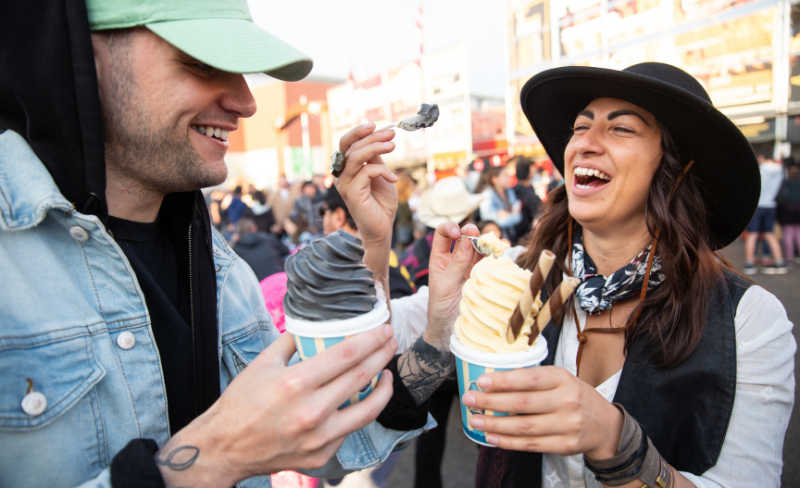Photo courtesy of Calgary Stampede
This month, we are examining the Calgary Stampede! Before the event even started this year, a lot of people had negative thoughts about it and how it was being pushed forward for financial reasons over health sanctions, and that the province was to blame.
However, as COVID-19 numbers took a major decline, people started to get used to the idea of outdoor and large festivals happening in Alberta again this summer. The Calgary Stampede took place over 10 days in early July and event planners from all over the province were tentatively waiting to see how this major event would turn out – would this event be a momentous success that the world could learn from, or a massive failure that would again put Alberta on the map as a province willing to take a gamble with peoples’ safety?
The Stampede is the benchmark for what is possible during a pandemic, but was the event a success? What was the actual damage in terms of COVID-19 outbreaks? What worked and what didn’t?
Prior to the multi-day event, you could find a lot of information on the Stampede’s website about what you could expect in terms of COVID-19 policies, and here’s what we found:
Proof of vaccination will not be required to enter Stampede Park. We will continue to follow the guidance of Alberta Health and Health Canada when it comes to vaccines and participation in activities. We also continue to explore rapid testing and proof of vaccination for entry to Nashville North.
We will be limiting Park capacity and with fewer people in more spaces to provide an atmosphere that is both safe and enjoyable. Guests can expect slightly fewer rides and enhanced safety and cleaning protocols and industry leading cleaning procedures throughout Stampede Park. Overall, the midway will have 25% less content – with our most popular midway rides and games returning – to increase open space for physical distancing.
After reading this, we were slightly disappointed with the lack of information regarding the pandemic and communication of what to expect when you went to the event. More than anything, this created more questions than answers. So, to further our research, we reached out to the Stampede for more information, and here’s what they said they were doing to keep COVID-19 at bay during their event:
Some of the safety enhancements that will be encountered at this year’s Stampede will be:
– Sanitization stations
– Controlled traffic and pre-purchased admission
– 25% more space on the grounds and wider corridors
– Encouraging of guest masking and adhering to any health guidelines
– Mandatory masking and a robust rapid testing program for frontline volunteers and employees
– Reduced lineups due to digital queuing system
– Enhanced safety and cleaning protocols – industry leading cleaning procedures throughout
Stampede Park– Reduced overall capacity
Again, not a lot of clarity, but most people attending were probably not very concerned with the pandemic at all, as most people that were nervous would have preferred to stay at home and enjoy the live stampede events via television and online methods. But you know us, we wanted to see if their methods would be in place and how effective they would actually be.
One of our tycoons went undercover and analyzed the event from beginning to end and this is what they found:
- Sanitization stations were everywhere you would expect (doorways, entryways), but not very many around the massive food truck alley, where most people are receiving food trays directly from non-gloved vendors.
- Traffic was controlled prior to getting into the venue and pre-purchased admission was an option; however, for those that chose to purchase at the door, there were no markers for keeping a 6’ space between people, and this can be said for the entirety of the grounds that we saw.
- Cannot comment on the space of the grounds, as some places felt larger, but some felt bottlenecked.
- Guest masking may have been encouraged, but very little people were, and that included some staff and almost all vendors that we saw.
- The lineups were not reduced for the Nashville North tent access. People wanting to get in had to scan a QR code that put them in a digital lineup and would text them when it was their turn to come to the line and then show proof of their vaccination status. However, hundreds of people would try to get in at the same time, so the line was still long to scan the code and even when you did get to the front of the line, it was possible for people to falsify their vaccination information as only a photo of your paper was required.
- Capacity may have been reduced, but later in the evening the most popular spots were filled with people. Also noted, was that the dance floors were still open and lots of crowds stopped to gather in front of the multiple stages indoors and outdoors.
Overall, it was clear that the Calgary Stampede was trying to implement some sort of COVID protection planning, but were not committed to making it the safest place possible. However, they did work within the current restrictions and mandates. “This time, it’s about the experience,” said the Calgary Stampede spokesperson, Kristina Barnes. “It’s really the first big live event that our country has seen in more than a year and a half, so this is about starting to get back to things that are a little bit more normal and focus on the experience more than money and numbers.”
In terms of outbreaks after the event, the case count rose dangerously high – and quickly! – but the Stampede took no responsibility for contributing to the rise, saying the cause was the province as a whole relaxing its health measures. Since the 10-day event took place, COVID cases continue to rise, but not as quickly as they were when the event began. It’s hard to determine exactly where the cases came from (only 18 were cited to have been found at the event and those persons were escorted off the premises immediately and asked to isolate at home for the remainder of the event) and where they were spread. We think it’s safe to say that there is a correlation with large events and the spread of pathogens.
To conclude, the Calgary Stampede has been viewed as Canada’s first step towards getting back to normalcy and opening events to larger crowds since the pandemic began. In an article from CTV Calgary, Mount Royal University’s marketing professor, David Finch, said the Stampede deserves full credit for being a symbol of Alberta’s re-opening strategy, but achieving greater safety confidence for attendees is still the biggest challenge. “There’s those people who are risk adverse all the way to those people who are risk takers and the number of people, according to our research, that are prepared to accept risk and go to large events is still relatively static at 40 per cent.”
We believe that greater measures could have been taken to ensure utmost safety to contain the virus, but with the amount of people at the event, that is very tough to do.
For ways to still gather safely and have fun, check out our Seasonal Event Guide for the remaining months of summer and through to fall!
– Your Tycoon, Steph XO

